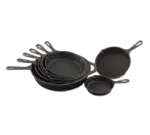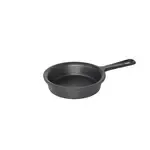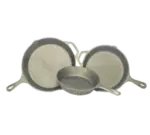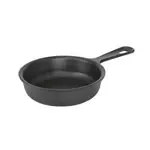
The Benefits of Cooking with a Cast Iron Skillet
Cooking has always been a blend of art and science, and the tools we use can significantly impact the outcome of our culinary endeavors. One such tool that has stood the test of time is the cast iron skillet. Known for its durability, versatility, and unique cooking properties, the cast iron skillet offers a range of benefits that make it a staple in many kitchens. In this article, we will explore why cooking with a cast iron skillet is a fantastic choice, how to care for it after use, its health benefits, and tips on maintaining it for longevity.
Why Choose a Cast Iron Skillet?
Excellent Heat Retention and Distribution
One of the most notable features of cast iron skillets is their ability to retain and evenly distribute heat. When properly preheated, they provide a consistent cooking surface that allows for better browning and searing. This is particularly advantageous when cooking meats or achieving a crispy crust on vegetables. The even heating minimizes the risk of hot spots, ensuring that your food cooks uniformly.
Versatility
Cast iron skillets are incredibly versatile. They can be used for a variety of cooking methods, including frying, baking, sautéing, and even roasting. You can transition from stovetop to oven seamlessly, making them ideal for dishes like cornbread, frittatas, or skillet pizzas. Some recipes even call for finishing a dish under the broiler, and a cast iron skillet can handle it all.
Durability and Longevity
With proper care, a cast iron skillet can last for generations. Unlike non-stick pans that may wear out over time, cast iron skillets develop a natural non-stick surface through seasoning, making them increasingly effective with use. They are resistant to chipping and scratching, making them a reliable choice for everyday cooking.
Natural Non-Stick Properties
When seasoned correctly, a cast iron skillet can develop a smooth, non-stick surface. Seasoning involves coating the skillet with oil and baking it, which creates a polymerized layer that prevents food from sticking. This process not only enhances the skillet's cooking surface but also helps protect it from rust.
Is Cooking with a Cast Iron Skillet Healthy?

Iron Enrichment
Cooking with cast iron has the added benefit of contributing dietary iron to your meals. Foods cooked in cast iron, especially acidic ones like tomatoes, can absorb trace amounts of iron. This can be particularly beneficial for individuals with iron deficiency or those looking to boost their iron intake naturally.
Chemical-Free Cooking
Cast iron skillets are free from harmful chemicals often found in non-stick cookware. Unlike some non-stick surfaces that can release toxic substances at high temperatures, cast iron is entirely safe to use at any heat level. This makes it an excellent choice for health-conscious cooks.
High-Temperature Cooking
Cast iron skillets can withstand high temperatures without releasing harmful fumes, making them perfect for searing meats and achieving that perfect crust. This is a critical aspect of cooking that promotes flavor development while ensuring that the cooking process remains safe.
How to Clean and Maintain Your Cast Iron Skillet
Cleaning After Use
Cleaning a cast iron skillet is straightforward, but it does require some specific techniques to maintain its seasoning. Here’s how to do it:
- Cool Down: Allow the skillet to cool slightly after cooking, but not completely. A warm skillet is easier to clean.
- Scrub: Use a stiff brush or a non-abrasive sponge to scrub off food residue. For stuck-on bits, you can add coarse salt and a little water to create a paste, which helps lift food without damaging the seasoning.
- Rinse: Rinse the skillet under warm water. Avoid using soap, as it can strip the seasoning.
- Dry Thoroughly: To prevent rust, dry the skillet completely with a cloth or place it on low heat for a few minutes to ensure all moisture evaporates.
- Re-season: After cleaning, apply a thin layer of cooking oil (such as vegetable or flaxseed oil) to the surface to maintain the seasoning and prevent rust.
Re-seasoning Your Skillet
Over time, the seasoning on your cast iron skillet may wear down. To re-season, follow these steps:
- Preheat your oven to 450°F (232°C).
- Clean the skillet thoroughly and dry it completely.
- Apply a thin layer of oil over the entire surface, inside and out.
- Place the skillet upside down in the oven (with a baking sheet on the lower rack to catch drips).
- Bake for an hour, then turn off the oven and let the skillet cool inside. This process helps build up the non-stick surface.
Choosing the Best Cast Iron Skillet

When selecting a cast iron skillet, consider the following factors:
Size
Cast iron skillets come in various sizes, typically ranging from 6 inches to 15 inches in diameter. A 10 to 12-inch skillet is ideal for most families, allowing for cooking a variety of dishes without taking up too much space.
Weight
Cast iron skillets are heavy, but the weight can vary between brands. Consider how comfortable you are lifting and maneuvering the skillet when making your choice.
Brand Reputation
When selecting a cast iron skillet, considering the brand reputation is essential. Here are some reliable options:
- Winco: Known for their commercial-grade kitchenware, Winco offers cast iron skillets that are durable and designed for everyday use.
- Browne: This brand specializes in high-quality cookware and provides a variety of cast iron skillets, ideal for both professional and home kitchens.
- Admiral Craft: Renowned for their robust kitchen tools, Admiral Craft offers skillets that are perfect for high-temperature cooking and long-lasting performance.
- Lodge: A classic American brand, Lodge is celebrated for its wide range of skillets, including popular sizes like 10.25-inch and 12-inch, known for excellent heat retention and versatility.
Choosing a skillet from these reputable brands will ensure you have quality cookware that stands the test of time.
Conclusion
Cooking with a cast iron skillet is more than just a trend; it's a time-honored practice that brings numerous benefits to the table. From excellent heat retention and versatility to health advantages and a long lifespan, these skillets have a lot to offer. With the right care and maintenance, a cast iron skillet can become one of your most valued kitchen tools, enhancing your cooking experience and providing delicious meals for years to come. Whether you're a novice cook or a seasoned chef, adding a cast iron skillet to your kitchen arsenal is a decision you won't regret.





